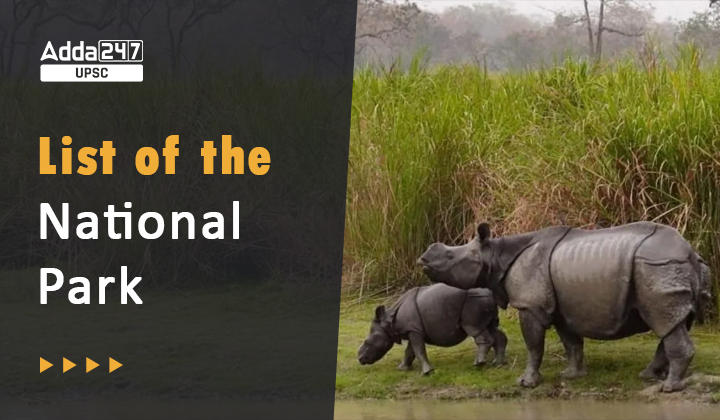Table of Contents
List of National Parks in India: India is blessed with an incredible diversity of flora and fauna, making it a haven for wildlife enthusiasts and nature lovers. Its Indo-Himalayan eco-zone alone showcases an impressive array of species, with approximately 6.2 percent reptiles, 7.6 percent mammals, 6.0 percent flowering plants, and 12.6 percent bird species.
The country’s forest cover spans a wide range, encompassing majestic coniferous forests in the Himalayan region to flourish tropical rainforests in Northeast India, the Western Ghats, and the tropical belt. India’s national parks, such as Jim Corbett National Park, Kaziranga National Park, and Bandhavgarh National Park, are sanctuaries that safeguard this incredible biodiversity for future generations to cherish.
What is National Park?
A National Park, is created for the conservation of wildlife and endangered animals and for environmental protection. National Parks have more stringent regulations compared to Wildlife Sanctuaries. They are established by the Indian government and do not allow tourism activities. The construction, establishment, and boundaries of these parks are determined by the government of India. The first National Park in India was established in 1936 and was initially known as Hailey National Park, but it is now called Jim Corbett National Park. This park is located in Uttarakhand.
List of National Parks in India
India has taken significant steps to protect its endangered species by establishing national parks across various states. The government has set up a remarkable network of conservation areas, comprising 104 National Parks, 551 Wildlife Sanctuaries, 131 Marine Protected Areas, 18 Biosphere Reserves, 88 Conservation Reserves, and 127 Community Reserves. These protected areas serve as vital habitats for a diverse range of flora and fauna, offering them a safe haven from human encroachment and unsustainable practices. Such conservation initiatives are crucial for preserving India’s rich biodiversity and ensuring the survival of endangered species for future generations. The establishment of these parks reflects the government’s commitment to wildlife conservation and environmental stewardship.
Here’s a complete state-wise List of National Parks in India.
| List of National Parks in India | ||
| Year | Name of the National Parks | State |
| 1936 | Corbett National Park | Uttarakhand |
| 1955 | Kanha National Park | Madhya Pradesh |
| 1955 | Tadoba National Park | Maharashtra |
| 1959 | Madhav National Park | Madhya Pradesh |
| 1968 | Bandhavgarh National Park | Madhya Pradesh |
| 1974 | Kaziranga National Park | Assam |
| 1974 | Bandipur National Park | Karnataka |
| 1974 | Bannerghatta National Park | Karnataka |
| 1975 | Gir National Park | Gujarat |
| 1975 | Gugamal National Park | Maharashtra |
| 1975 | Navegaon National Park | Maharashtra |
| 1975 | Pench National Park | Madhya Pradesh |
| 1976 | Blackbuck National Park | Gujarat |
| 1976 | Guindy National Park | Tamil Nadu |
| 1977 | Keibul-Lamjao National Park | Manipur |
| 1977 | Khangchendzonga National Park | Sikkim |
| 1977 | Dudhwa National Park | Uttar Pradesh |
| 1978 | Eravikulam National Park | Kerala |
| 1979 | Vansda National Park | Gujarat |
| 1979 | Van Vihar National Park | Madhya Pradesh |
| 1980 | Simlipal National Park | Odisha |
| 1980 | Ranthambore National Park | Rajasthan |
| 1980 | Gulf of Mannar Marine National Park | Tamil Nadu |
| 1981 | Guru Ghasidas (Sanjay) National Park | Chhattisgarh |
| 1981 | Dachigam National Park |
Jammu & Kashmir
|
| 1981 | Hemis National Park |
Jammu & Kashmir
|
| 1981 | Kishtwar National Park |
Jammu & Kashmir
|
| 1981 | Panna National Park | Madhya Pradesh |
| 1981 | Sanjay National Park | Madhya Pradesh |
| 1981 | Satpura National Park | Madhya Pradesh |
| 1981 | Keoladeo Ghana National Park | Rajasthan |
| 1982 | Indravati National Park | Chhattisgarh |
| 1982 | Kanger Valley National Park | Chhattisgarh |
| 1982 | Marine National Park | Gujarat |
| 1982 | Periyar National Park | Kerala |
| 1982 | Nanda Devi National Park | Uttarakhand |
| 1982 | Valley of Flowers National Park | Uttarakhand |
| 1983 | Mahatma Gandhi Marine National Park |
Andaman & Nicobar Islands
|
| 1983 | Namdapha National Park |
Arunachal Pradesh
|
| 1983 | Fossil National Park | Madhya Pradesh |
| 1983 | Sanjay Gandhi National Park | Maharashtra |
| 1983 | Rajaji National Park | Uttarakhand |
| 1984 | Great Himalayan National Park |
Himachal Pradesh
|
| 1984 | Silent Valley National Park | Kerala |
| 1984 | Sunderban National Park | West Bengal |
| 1985 | Balpakram National Park | Meghalaya |
| 1986 | Mouling National Park |
Arunachal Pradesh
|
| 1986 | Betla National Park | Jharkhand |
| 1986 | Nokrek Ridge National Park | Meghalaya |
| 1986 | Neora Valley National Park | West Bengal |
| 1986 | Singalila National Park | West Bengal |
| 1987 | Middle Button Island National Park |
Andaman & Nicobar Islands
|
| 1987 | Mount Harriet National Park |
Andaman & Nicobar Islands
|
| 1987 | North Button Island National Park |
Andaman & Nicobar Islands
|
| 1987 | Saddle Peak National Park |
Andaman & Nicobar Islands
|
| 1987 | South Button Island National Park |
Andaman & Nicobar Islands
|
| 1987 | Pin Valley National Park |
Himachal Pradesh
|
| 1987 | Anshi National Park | Karnataka |
| 1987 | Kudremukh National Park | Karnataka |
| 1988 | Nagarahole (Rajiv Gandhi) National Park | Karnataka |
| 1988 | Bhitarkanika National Park | Odisha |
| 1989 | Sri Venkateswara National Park | Andhra Pradesh |
| 1989 | Valmiki National Park | Bihar |
| 1989 | Sultan National Park | Haryana |
| 1989 | Indira Gandhi (Annamalai) National Park | Tamil Nadu |
| 1989 | Gangotri National Park | Uttarakhand |
| 1990 | Manas National Park | Assam |
| 1990 | Mudumalai National Park | Tamil Nadu |
| 1990 | Mukurthi National Park | Tamil Nadu |
| 1990 | Govind National Park | Uttarakhand |
| 1991 | Murlen National Park | Mizoram |
| 1992 | Campbell Bay National Park |
Andaman & Nicobar Islands
|
| 1992 | Galathea Bay National Park |
Andaman & Nicobar Islands
|
| 1992 | Mollem National Park | Goa |
| 1992 | City Forest (Salim Ali) National Park |
Jammu & Kashmir
|
| 1992 | Phawngpui Blue Mountain National Park | Mizoram |
| 1992 | Desert National Park | Rajasthan |
| 1992 | Sariska National Park | Rajasthan |
| 1992 | Buxa National Park | West Bengal |
| 1992 | Gorumara National Park | West Bengal |
| 1993 | Intanki National Park | Nagaland |
| 1994 | Kasu Brahmananda Reddy National Park | Telangana |
| 1994 | Mahaveer Harina Vanasthali National Park | Telangana |
| 1994 | Mrugavani National Park | Telangana |
| 1996 | Rani Jhansi Marine National Park |
Andaman & Nicobar Islands
|
| 1998 | Nameri National Park | Assam |
| 1999 | Dibru-Saikhowa National Park | Assam |
| 1999 | Rajiv Gandhi Orang National Park | Assam |
| 2003 | Kalesar National Park | Haryana |
| 2003 | Anamudi Shola National Park | Kerala |
| 2003 | Mathikettan Shola National Park | Kerala |
| 2003 | Pampadum Shola National Park | Kerala |
| 2004 | Chandoli National Park | Maharashtra |
| 2005 | Rajiv Gandhi (Rameswaram) National Park | Andhra Pradesh |
| 2006 | Mukundra Hills National Park | Rajasthan |
| 2007 | Clouded Leopard National Park | Tripura |
| 2007 | Bison National Park | Tripura |
| 2008 | Papikonda National Park | Andhra Pradesh |
| 2010 | Inderkilla National Park |
Himachal Pradesh
|
| 2010 | Khirganga National Park |
Himachal Pradesh
|
| 2010 | Simbalbara National Park |
Himachal Pradesh
|
| 2014 | Jaldapara National Park | West Bengal |
Largest National Parks in India
Hemis National Park, established in 1981, originally covered an area of about 600 sq km. Over time, it expanded significantly to a remarkable size of 4,400 sq km. This makes Hemis National Park the largest national park not just in India but also in the entire South Asia region.
| S. No | National Park in India | Year (km Square) |
| 1 | Hemis National Park | 4,400.00 |
| 2 | Desert National Park | 3,162.00 |
| 3 | Gangotri National Park | 2390 |
| 4 | Namdapha National Park | 1985.2 |
| 5 | Khangchendzonga National Park | 1784 |
| 6 | Guru Ghasidas (Sanjay) National Park | 1440.7 |
| 7 | Gir National Park | 1412 |
| 8 | Sundarbans National Park | 1330.1 |
| 9 | Jim Corbett National Park | 1318.5 |
| 10 |
Indravati National Park
|
1258.4 |
How Many National Parks in India?
There are 106 existin6g national parks in India covering an area of 44,402.95 km2, which is 1.35% of the geographical area of the country (National Wildlife Database, Jan. 2023).
Importance of National Park
National parks play a crucial role in conservation and environmental protection. They are of great importance for several reasons:
Biodiversity Conservation: National parks preserve and protect a wide range of plant and animal species, including endangered and threatened species. They provide a safe and undisturbed habitat for these species, allowing them to thrive and ensuring their long-term survival.
Ecological Balance: National parks help maintain ecological balance by preserving natural ecosystems and their interdependencies. They support various ecological processes, such as nutrient cycling, pollination, and natural predator-prey relationships, which are vital for the overall health and functioning of the ecosystem.
Watershed Protection: Many national parks encompass watersheds, acting as natural filters and regulators of water resources. They help maintain water quality, regulate water flow, and contribute to the recharge of groundwater, benefiting both wildlife and human populations downstream.
Research and Education: National parks serve as living laboratories for scientific research and provide opportunities for studying and understanding biodiversity, ecosystem dynamics, and environmental changes. They also play a crucial role in environmental education, raising awareness about conservation, and promoting sustainable practices.
Recreation and Tourism: National parks offer recreational opportunities for visitors, allowing them to connect with nature, enjoy outdoor activities, and experience the beauty and diversity of natural landscapes. Tourism in national parks also contributes to local economies and promotes cultural appreciation.
Climate Change Mitigation: National parks act as carbon sinks, absorbing and storing carbon dioxide from the atmosphere. They play a role in mitigating climate change by preserving forests, which are essential in sequestering carbon and reducing greenhouse gas emissions.
| Important Article | |
| List of Prime Ministers of India | List of Presidents of India |
| Freedom Fighters of India List | भारत के कैबिनेट मंत्रियों की सूची 2023 |
| Follow US |
|
| UPSC Govt Jobs UPSC Current Affairs UPSC Judiciary PCS Download Adda 247 App here to get the latest updates |


 UPSC Eligibility Criteria 2024- Check Ag...
UPSC Eligibility Criteria 2024- Check Ag...
 APSC Notification 2024, Check Mains Exam...
APSC Notification 2024, Check Mains Exam...
 KPSC KAS Exam Notification 2024, Check t...
KPSC KAS Exam Notification 2024, Check t...







